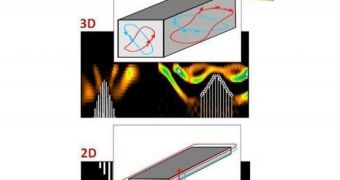Once it was thought that the quantum Hall effect is experienced in materials under the influence of external magnetic fields, albeit Princeton University researchers revealed that it may also be experienced in bulk bismuth-antimony crystal without any interference from magnetic fields. The discovery could possibly lead to the creation of quantum or 'spintronic' computing devices, and other electronic technology advancements.
"We had the right tool and the right set of ideas. We had the right material," says Zahid Hasan, Princeton University assistant professor of physics. The behavior of electrons inside the bismuth-antimony crystal was observed with the help of a technique called "synchrotron photo-electron spectroscopy", in which the surface of the material is scanned with the help of a bright beam of X-ray light.
Inside semiconductors, the quantum Hall effect is only experienced in the presence of intense magnetic fields. By creating bismuth-antimony crystals, then subjecting them to extreme conditions researchers such as Rober Cava, leader of the study and Russell Wellman Moon Professor of Chemistry, hopped to understand how electrons move in such materials.
"This is one of those wonderful examples in science of an intense, extended collaboration between scientists in different fields," says Cava.
"This remarkable experiment is a major home run for the Princeton team, which will spark a worldwide scramble to understand the new states and a major program to manipulate them for new electronic applications," said professor of physics Phuan Ong from Princeton University, who did not participate in the study.
The quantum Hall effect was discovered in the late 1870s by Edwin Hall. It was shown that electrons inside a conductive material are driven by magnetic fields towards the edges of the material, and are picked up as a rise in electrical voltage when electrical current is being applied on the perpendicular direction. More than a century later, German physicist Klaus von Klitzing revealed that the electric voltage inside a material experiencing the quantum Hall effect rises in chunks rather than small increments as previously believed. His work was rewarded five years later with a Nobel Prize.
Following the work of von Klitzing, Daniel Tsui from Princeton University conducted similar experiments along with Horst Stormer from the Bell Laboratories, and showed in 1982 that electrons inside a material experiencing the quantum Hall effect seem to move in a 'quantum fluid', each with identical spins.
A year later, Robert Laughlin from Stanford University created a model through which the behavior of the electrons inside the 'quantum fluid' determine a new phenomenon, eddies and waves, therefore proving that electrons subjected to a powerful magnetic field condensed into a quantum fluid experienced in a superconductive state. He would later win the Nobel Prize in physics along with Stormer and Tsui.
Charles Kane from the University of Pennsylvania created a new model based on that proposed by Duncan Haldane from Princeton University, in which he showed that materials may experience a Hall-like effect under certain conditions without the need of external magnetic fields. In this case, the electrons spin directions met and produce their own internal magnetic field.
Hasan's team is the first to measure this effect inside a crystal of bismuth-antimony through a synchrotron photo-electron spectroscopy technique. "This experiment opens the door to a wide range of further studies," says Kane, Penn State University theorist.
"What is exciting about this new method of looking at the quantum Hall-like behavior is that one can directly image the electrons on the edges of the sample, which was never done before. This very direct look opens up a wide range of future possibilities for fundamental research opportunities into the quantum Hall behavior of matter," says Hasan.

 14 DAY TRIAL //
14 DAY TRIAL //